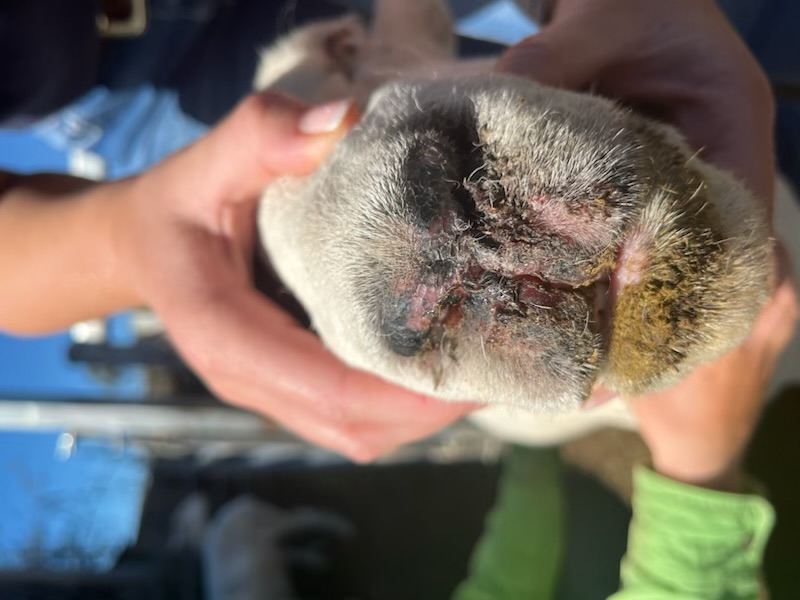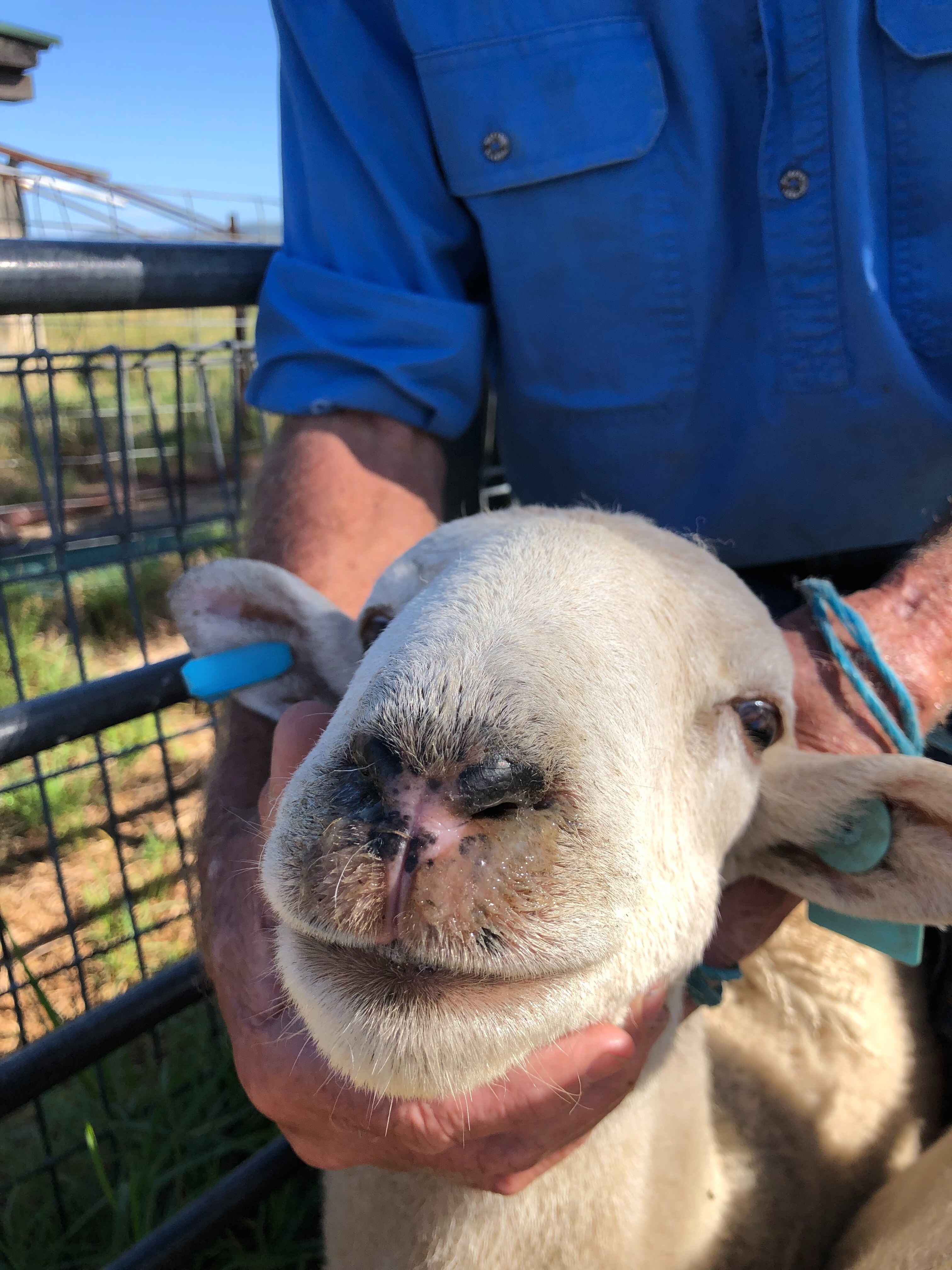
Bluetongue virus
NOTIFIABLE: If you suspect your cattle or sheep have Bluetongue virus, you must immediately notify the Emergency Animal Disease Hotline: 1800 675 888 or Local Land Services: 1300 795 299
All ruminant species (cattle, sheep, goats and camelids) are susceptible to infection with bluetongue virus (BTV). However, bluetongue is primarily a sheep disease. Australia has a recognised BTV zone and monitoring of BTV distribution is undertaken by the National Arbovirus Monitoring Program (NAMP).
Does bluetongue affect people?
Bluetongue does not affect people.
What is bluetongue?
Bluetongue is an arbovirus that affects ruminants. Arboviruses are a group of viruses that are transmitted by insects. Bluetongue virus (BTV) is spread by insect vectors, Culicoides midges, feeding on viraemic or sick animals. Bluetongue is not transmitted directly between animals.
How is bluetongue spread?
Bluetongue virus (BTV) is spread by insect vectors, Culicoides midges, feeding on affected animals. Bluetongue is not transmitted directly between animals.

In NSW, BTV transmission occurs regularly on the northern coastal plain to the Hunter Valley and less regularly in the Northern Tablelands, North West Slopes, Sydney Basin and South Coast regions. A map of the area, known as the Bluetongue Transmission Zone is available here: https://namp.animalhealthaustralia.com.au/public.php.
Thirteen bluetongue serotypes have been recorded in Australia. These are serotypes 1, 2, 3, 4, 5, 7, 9, 12, 15, 16, 20, 21 and 23. BTV-1, BTV-16 and BTV-21 have been detected throughout the endemically or naturally occurring affected area of NSW. BTV-15 has been detected on the far north coast of NSW in a single year, 2022 only.
Infection in cattle, although of great epidemiological significance, is usually subclinical, with no visible signs of disease. The ability of different strains of bluetongue to cause disease varies significantly.
The disease is most likely to occur in late summer or early autumn due to the build-up of virus numbers in cattle and increasing vector populations with warmer weather.
In Australia, clinical disease is rare in sheep and has never been reported in any other susceptible animal species. Cases have been reported in two commercial sheep flocks in the Northern Tablelands in autumn 2023. The mortality rate is variable in sheep and generally ranges from zero to 30% depending on the virus strain and sheep genetics.

What does bluetongue (BTV) look like in sheep?
Clinical signs may range from acute to mild and typically involve:
- fluctuating fever
- hyperaemia or reddening) and haemorrhages or bruising or bleeding) on oral and nasal membranes
- excess salivation and nasal discharge
- lips and tongue may become swollen, and the swelling may extend over the face and under the jaw
- ulcers develop on the gums, cheek and tongue 5 to 8 days after the onset of fever
- feet lesions may appear towards the end of the febrile period, including reddening and petechial bruising on the coronary band (i.e., at the top of the hoof). The associated pain causes the animals to stand with arched backs and be reluctant to move.



Image 1: BTV1 affected sheep showing hyperaemia or reddening on oral mucosae with ulcers developing on the gums.
Image 2: BTV1 affected sheep showing muzzle lesions and scabs, with secondary to swelling of the nose and lips, and lower jaw.
Image 3: BTV1 affected sheep showing swelling over the face and submandibular space under the jaw.

What are the differential diagnoses for BTV in sheep?
- scabby mouth (contagious pustular dermatitis)
- acute photosensitisation
- lameness due to footrot, foot abscess and other foot conditions
- acute infection with Barber’s pole worm (with depression and submandibular oedema)
- facial eczema
- pneumonia
- plant poisoning
- salmonellosis
- sheep pox
- foot-and-mouth disease
- peste des petits ruminants.

What should I do if I suspect bluetongue?
Bluetongue in sheep, goats and cattle is a notifiable disease in NSW. This means you have a legal duty to report all suspect BTV animals in your care.
If you suspect BTV, see signs of disease or death consistent with bluetongue in your flock or herd, immediately contact the 24-hour Emergency Animal Disease Watch Hotline, 1800 675 888 or your Local Lands Services District Veterinarian, 1300 295 299.

How is bluetongue diagnosed?
Diagnosis is supported by animal health and property history, clinical signs, confirmation of infection by laboratory testing, including PCR or virus isolation and the post-mortem finding of haemorrhages in the artery wall at the base of the pulmonary artery at the heart, which is considered characteristic of bluetongue.
More information about diagnostic tests and laboratory submission forms: https://www.dpi.nsw.gov.au/about-us/services/laboratory-services/veterinary/bluetongue.
Highest concentrations of virus in the blood usually occur during the early stage of disease before antibodies develop but virus can be reliably detected for at least 7 to 10 days after the onset of disease and usually much longer when using qRT-PCR.

I have had an endemic, or naturally occurring strain of BTV detected in my flock or on my property. What do I need to know?
Once an endemic strain of BTV is confirmed, the property will be placed under an Individual Biosecurity Direction.
As a precaution the movements of sheep from affected properties will be restricted until the end of the vector season. Depending on your property location, this may coincide with when the first frosts occur or when NAMP testing for the season concludes and the Culicoides vector is no longer present. This is to ensure no sheep or sheep products leave the BTV transmission zone.
Some movements, however, may still be allowed on a case-by-case basis as determined by NSW DPIRD. For example, cases where sheep go direct to slaughter or low risk movements within the existing BTV zone may be allowed. Movement of sheep will be allowed after the end of the 2024 vector season when Culicoides midges are no longer active.
It is important affected sheep owners and managers and/or their veterinarians continue contact with their Local Land Services District Vet (DV) or NSW DPIRD staff during this period so they can work with you to protect your farm and the region’s livestock industry.
No ruminants or their products will be eligible for export from confirmed infected properties during the transmission period, including cattle, goats, sheep and wool, due to the requirements of importing countries.
There is no treatment for the virus. Supportive therapy may assist the animals during recovery. Please discuss this with your veterinarian. Protection from insect bites may be helpful but may not be practical. Separating sheep and cattle may assist in reducing midge attack on the sheep.
Other key information

Prevention and management
Vaccines are available overseas and can be used to protect susceptible animals against clinical disease if a need arises.
Protection from insect bites using insecticides and repellents may be helpful but may not be practical in substantially reducing transmission of BTV in most circumstances.

Why does NAMP monitor for arboviruses?
Some countries that import live sheep, goats and cattle are concerned about the presence of bluetongue viruses in Australia. These countries require ongoing assurance that livestock imported from Australia are free of these viruses. NAMP provides the necessary evidence on which to base these assurances.
NAMP provides a bluetongue early warning system through surveillance within the BTV transmission zone. The system detects incursions of exotic strains of BTV and its vectors, Culicoides species biting midges, that have the potential to adversely affect livestock production in Australia and trade.
NAMP assists producers and exporters to manage risk by detecting changes in seasonal distribution of vectors and showing the likelihood of arboviruses affecting stock in particular areas.
More information about the NAMP and arbovirus monitoring, impacts to export trade and markets is available from Animal Health Australia.

How does NAMP operate in NSW?
NAMP carries out its disease monitoring in two ways:
- sampling and testing for antibodies in sentinel cattle
- trapping insects to check for the presence of insect vectors.
NSW DPIRD takes blood samples from sentinel cattle at strategic sites in NSW regularly to detect the presence of bluetongue, Akabane and bovine ephemeral fever. We sample young cattle after weaning and then sample the same animals during and after the time when insect vectors are expected to be active, and transmission of the virus is likely to occur, to examine whether they have been exposed to the viruses. The NSW DPIRD Animal Health and Plant Laboratory at Elizabeth Macarthur Agriculture Institute analyses the samples and refers all samples where bluetongue virus is suspected to the Australian Centre for Disease Preparedness (ACDP) in Geelong.
Seasonal and environmental factors influence the distribution of viruses and their vectors. Traps are set to collect insect vectors at selected sites in NSW. Entomologists examine the contents of the traps for the presence of specific insects that can spread viruses of interest to NAMP.
Resources
- Animal Health Australia’s AUSVETPLAN Bluetongue Disease Strategy: https://animalhealthaustralia.com.au/download/1622
- Bluetongue virus zone map: https://namp.animalhealthaustralia.com.au/public.php
- Veterinary Testing for Bluetongue: https://www.dpi.nsw.gov.au/about-us/services/laboratory-services/veterinary/bluetongue
- Information for private vets
- Information for producers
- Bluetongue Veterinary field investigation questionnaire
- Bluetongue virus - Veterinary sampling key list
- BTV clinical cases presentation (Dr Heidi Austin, North West LLS)

